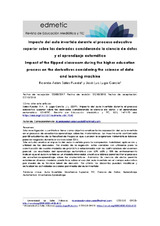| dc.contributor.author | Salas-Rueda, Ricardo-Adán | |
| dc.contributor.author | Lugo-García, José-Luis | |
| dc.date.accessioned | 2019-02-18T10:38:22Z | |
| dc.date.available | 2019-02-18T10:38:22Z | |
| dc.date.issued | 2019 | |
| dc.identifier.issn | 2254-0059 | |
| dc.identifier.uri | http://hdl.handle.net/10396/17879 | |
| dc.description.abstract | Esta investigación cuantitativa tiene como objetivo analizar la incorporación del aula invertida en el proceso de enseñanza-aprendizaje sobre las matemáticas. La muestra está conformada por 88 estudiantes de la Facultad de Negocios que cursaron la asignatura Matemáticas básicas para los negocios durante el ciclo escolar 2016.
Este estudio analiza el impacto del aula invertida para la compresión, habilidad, aplicación y utilidad de las derivadas. Por medio de la regresión, estas variables son utilizadas para la construcción de cuatro modelos de pronóstico relacionados con las calificaciones del examen parcial. Los resultados del aprendizaje automático con 50%, 60% y 70% de entrenamiento indican que el aula invertida es un modelo innovador, creativo e idóneo para facilitar el proceso de enseñanza-aprendizaje sobre las matemáticas. Asimismo, la ciencia de datos permite establecer diversos modelos predictivos sobre el uso del aula invertida en el campo educativo por medio de la técnica árbol de decisión. Por último, los docentes pueden modificar y actualizar las actividades escolares por medio del aula invertida | es_ES |
| dc.description.abstract | This quantitative research aims to analyze the incorporation of the flipped classroom in the teaching-learning process on mathematics. The sample consists of 88 students of the Business School who studied the subject Basic Mathematics for Business during the 2016 school year. This study analyzes the impact of the flipped classroom for the compression, skill, application and utility of the derivatives. By means of regression, these variables are used for the construction of four forecast models related to the grade of the partial exam. The results of learning machine with 50%, 60% and 70% of training indicate that the flipped classroom is an innovative, creative and ideal model to facilitate the teaching-learning process on mathematics. Likewise, the science of data allows establishing different predictive models on the use of the flipped classroom in the educational field by means of the decision tree technique. Finally, teachers can modify and update school activities through the flipped classroom. | es_ES |
| dc.format.mimetype | application/pdf | es_ES |
| dc.language.iso | spa | es_ES |
| dc.publisher | UCOPress | es_ES |
| dc.rights | https://creativecommons.org/licenses/by/3.0/ | es_ES |
| dc.source | Edmetic 8 (1), 147-170 (2019) | es_ES |
| dc.subject | Aula invertida | es_ES |
| dc.subject | Enseñanza superior | es_ES |
| dc.subject | TIC | es_ES |
| dc.subject | Ciencia de Datos | es_ES |
| dc.subject | Aprendizaje automático | es_ES |
| dc.subject | Enseñanza-aprendizaje | es_ES |
| dc.subject | Flipped classroom | es_ES |
| dc.subject | Higher education | es_ES |
| dc.subject | ICT | es_ES |
| dc.subject | Data science | es_ES |
| dc.subject | Machine learning | es_ES |
| dc.subject | Teaching-learning | es_ES |
| dc.title | Impacto del aula invertida durante el proceso educativo sobre las derivadas | es_ES |
| dc.title.alternative | Impact of the flipped classroom during the higher education process on the derivatives considering the science of data and learning machine | es_ES |
| dc.type | info:eu-repo/semantics/article | es_ES |
| dc.relation.publisherversion | http://www.uco.es/ucopress/ojs/index.php/edmetic/index | es_ES |
| dc.rights.accessRights | info:eu-repo/semantics/openAccess | es_ES |

